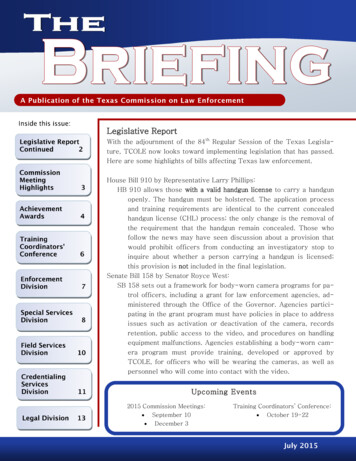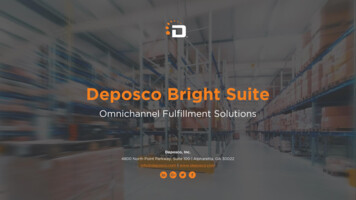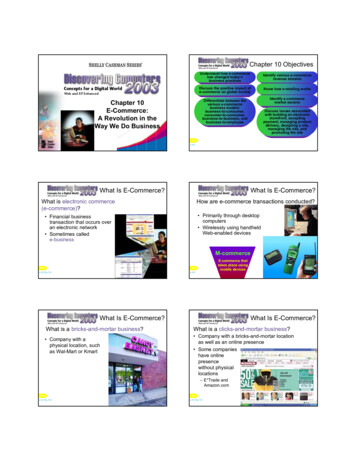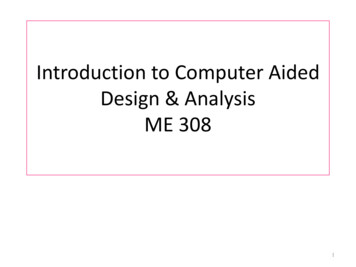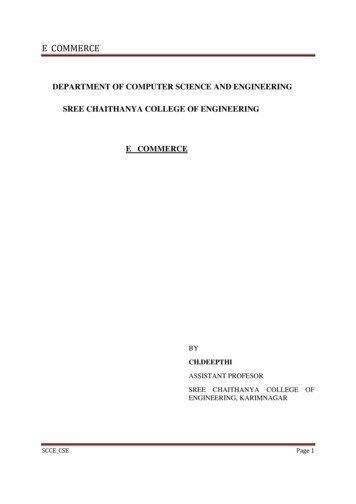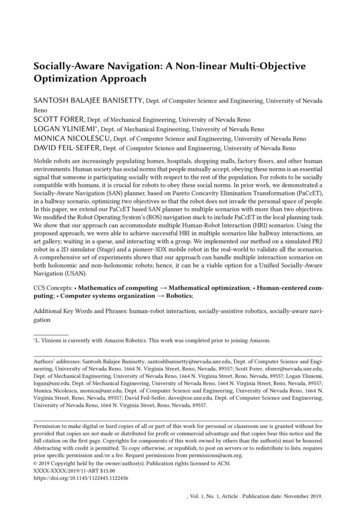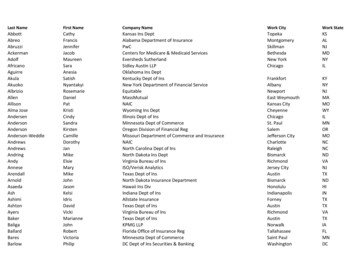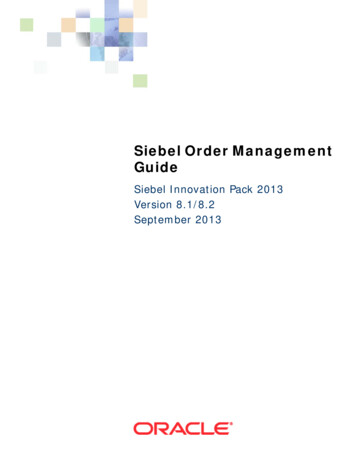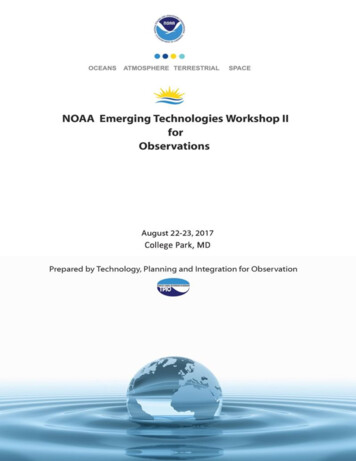
Transcription
PrefaceThe NOAA Observing Systems Council (NOSC) hosted its second workshop on EmergingTechnologies for Observations (ETW) on August 22 and 23, 2017. Due to the success of the firstworkshop in 2016, the NOSC expanded the workshop into a two-day event and invited scientistsfrom both within the Agency as well as NOAA’s external partners in the private sector, includingmembers of academia, industry, other governmental agencies, and affiliates to NOAA. The eventwas held at the NOAA Center for Weather and Climate Prediction (NCWCP) in College Park,Maryland, with 260 participants in attendance.The 2017 ETW theme was “Technology toward a mission-effective, integrated, adaptable, andaffordable observation portfolio.” The workshop included seven sessions that enabled NOAAleadership to interact with researchers, analysts, and practitioners from space, atmosphere,terrestrial, and oceans observing domains. Day One consisted of four sessions in which speakersfrom NOAA and NOAA affiliates examined emerging technologies from each observing domain.Day Two consisted of two sessions in which speakers from the private sector focused onidentifying ways to fill specific gaps in NOAA’s observing system portfolio. The remaining sessionwas a cross-cutting session discussing data management and analytics. The workshop concludedwith an interagency panel session to share ideas on how to transition emerging technologies tooperational use within their own agencies and organizations. The workshop featured 34presentations and 40 poster gallery exhibits.The workshop hosts were the Observing Systems Committee (OSC) co-chairs, Mr. Joseph Pica(National Weather Service) and Mr. Richard Edwing (National Ocean Service). This reportcontains summaries of the keynote speeches and main presentations, followed by a summary ofthe panel discussion, and recommendations for future workshops. The appendices contain theETW agenda, conference links, and post-workshop survey results.
Table of ContentsKeynote Address . 1Workshop Sessions. 3Space Session . 4Atmosphere Session . 6Terrestrial Session . 9Oceans Session . 12Oceans Requirements Gaps Session . 14Land-Atmosphere Requirements Gaps Session . 16Data Management and Analytics Session . 19Emerging Technologies Panel Discussion . 21Findings and Recommendations . 24Appendices . 25Appendix 1: Agenda . 25Appendix 2: Links to Workshop Materials . 29Appendix 3: Post-Workshop Survey . 31Appendix 4: NOAA Observing Systems Council (NOSC) . 34Appendix 5: Observing Systems Committee (OSC) . 35Appendix 6: Technology, Planning and Integration for Observation (TPIO) . 36
NOAA ETW Workshop II – August 22 -23, 2017Keynote AddressDr. Stephen VolzAssistant Administrator for Satellite and Information Services;Acting Chair of NOAA’s Observing Systems Council (NOSC); andActing Assistant Secretary for Environmental Observations and PredictionThe Emerging Technologies Workshop (ETW) is the key to managing, directing, advancing, andimproving NOAA’s breadth of observing systems and information gathering services. Thisresponsibility is felt keenly by NOAA and all of NOAA’s partners because we recognize the valueof what we do, even when it is not realized by those who receive and utilize our services.Over the past two years, NOAA has used the ETW to look at how new data and new observationsystems can be productively and effectively integrated into existing structures. NOAA uses theETW to try to determine how NOAA can not only stay fresh with current technology, but howNOAA can stay at the cutting edge of technologies for observations and predictions to maintainits position as the leader of Earth observations nationally, as well as globally. As such, one of thekey challenges that NOAA and its commercial and academic partners face is determining how toenhance and expand existing observing systems.NOAA has the responsibility to observe the whole planet. NOAA’s charter is to observe the planet,understand what is observed, and to protect and inform the U.S. public so that they can makeaccurate and reliable decisions based on the information provided. In short, one of NOAA’s goalsis to provide the public with knowledgeable information that they can actually work with.NOAA uses an incredible breadth of observing systems that span from the bottom of the oceanto the surface of the sun. Making observations that encompass the entire planet and itsatmosphere is one of NOAA’s greatest challenges. The first part of this challenge is simply makingthe observations. The second part of this challenge is making observations consistently, reliably,and productively over the long term.For the past two years, NOAA’s Observing Systems Council (NOSC) and its partners andresearch organizations have worked to integrate the platforms users utilize to determine how allof the observing systems can most effectively work together. NOSC has determined that it iscritical that these systems be managed as a single system rather than a multitude of separateobserving systems.One of NOAA’s most significant challenges is determining how older but still well-performingsystems can evolve into new systems that perform just as well or better in the future. Specifically,NOAA is faced with the challenge of taking older systems that have been in place for years andevolving them so that in 10, 20, and 30 years NOAA is using the best technologies with the bestcapabilities. In the past, the government would likely have been able to provide solutions for eachobserving system; however, in the future, solutions for evolving observing systems will almostcertainly not come solely from the government. Instead, new solutions will likely come from thecommercial sector as well. For instance, commercial systems are already providing qualityweather observations in some areas, and NOAA is working with the commercial sector todetermine how the government and commercial sectors can work together to deliver newobserving systems in an integrated systems architecture.1
NOAA ETW Workshop II – August 22 -23, 2017It is NOAA’s role as part of the government and as the integrator of all observing systems toensure that the products and services provided to the public are consistent and reliable so thatusers do not have to worry about where data comes from. NOAA and its interagency,international, and commercial partners are part of a brand defined by reliability and accuracy. Aspart of this, NOAA’s role in the ETW is to determine how best to merge new technologies andcapabilities, including through partnerships with national and commercial sectors, into existingobserving systems. Successful merging of these elements will allow NOAA to retire olderobserving systems while simultaneously deploying new observing systems, which will provide aseamless delivery of services and information.Currently, one of NOAA’s most critical services is providing a context for its forecasts andobservations. NOAA uses archival and current datasets to provide context to help determinewhether an event is an anomaly or typical for a specific phenomenon. NOAA must continue toprovide this context, and having the best observing systems is crucial to maintaining an observingcontext that allows us to see how different observations fit together. As part of this, one of theenduring ETW goals is to refresh existing observing systems. NOAA has well-performingsystems, but they are ageing and are ready to be replaced or invigorated with new technology.The observing system challenge that NOAA faces is how to integrate new datasets and newcapabilities into our operational systems. Often the focus is on the observing systems themselveswhen we should actually be focusing on why the observations are needed, who the users are,and what is the expected impact of the measurements and information. Also of importance is howNOAA provides the translation between the observing systems and the information products weprovide. Ultimately, NOAA must begin with the requirements of the user community, interpret newtechnologies to determine if they are usable and compatible with existing and future systems, andprovide the new capabilities in a sustainable and consistent way.An example of how NOAA is replacing an older observing system with a new observing systemis happening right now with the global ocean buoy system. NOAA deploys ocean buoys aroundthe globe that provide information on sea surface conditions, salinity, temperatures, and surfaceweather conditions. The buoys used in NOAA’s legacy buoy network, while reliable, are big, bulky,difficult to deploy, hard to re-service, and have reached the end of their service life. As such,NOAA’s National Data Buoy Center developed a replacement buoy system, the Self-ContainedOcean Observations Payload or SCOOP, that is modular, more compact, less labor intensive,easier to deploy, and uses new technologies that can provide the same information. By the mid2020s, the SCOOP system will have completely replaced the older system. NOAA’s challenge,however, is not simply to replace older observing systems, but to continually refresh and replenishall existing and new observing systems whether they are buoys, aircraft measurements, satellites,or any of the other myriad observing systems that NOAA employs. The current example is one ofan individual replacement, but other situations could be more significant and require architecturalchanges.Ultimately, NOAA’s key challenge is to determine the viability of new emerging technologies andhow they can be integrated and merged into existing observing systems. Forums such as theETWs are crucial to this endeavor because they keep us informed of current capabilities and whatis on the horizon of being viable for observing systems. The ETW also provides a forum forongoing dialog between NOAA and the commercial and research communities to discuss userneeds, NOAA systems requirements and capabilities, and future plans and opportunities. Mergingand integrating new technologies does not happen overnight, but NOAA is committed toidentifying incremental steps and midterm projections and activities that allow us to make betterinformed decisions for our observing systems.2
NOAA ETW Workshop II – August 22 -23, 2017Workshop SessionsThe goal of the Emerging Technologies Workshop is to promote a broader awareness of newinnovations and technologies that are on the horizon and could potentially be incorporated intoNOAA’s observing system portfolio. This year’s workshop maintained a strong focus on the fourprimary domains (space, atmosphere, terrestrial, and oceans), but also expanded to include tworequirements gaps sessions, a data management and analytics session, and an emergingtechnologies panel discussion. The theme of the workshop, “Technology toward a missioneffective, integrated, adaptable, and affordable observation portfolio,” was integral to all of thesessions.The Emerging Technologies Workshop is part of an important effort to establish more forums forsharing ideas, technologies, challenges, and encouraging greater collaboration among differentsectors and fields. The workshop is instrumental in helping to determine where synergies mightoccur among different sectors, and forging meaningful partnerships for collaboration.This year’s ETW included two Request for Information (RFI) requirements gaps sessions, the“Oceans Requirements Gaps Session” and the “Land-Atmosphere Requirements Gaps Session,”that were intended to address unfulfilled high priority requirements that are limiting theperformance of NOAA due to lowered performance of highly relevant products associated withrequirements. The products and technologies included in the two RFI requirements gaps sessionswere solicited through an Acquisition of Grants Office (AGO) RFI that targeted commercialvendors with proven technical capabilities appropriate for fulfilling information gaps. To identifywhich specific products to include in the ETW, NOAA employed a gap analysis methodology todetermine which products, if improved, would yield appreciable “top-node” improvements ( 33%)at the mission and NOAA level, and which products had room for improvement and were highlyrelevant and impactful to NOAA. Additional and more in-depth criteria were also utilized to identifythe most appropriate and relevant products.This year’s workshop also included a new session on Data Management and Analytics. The DataManagement and Analytics Session was added to address the growing importance of data inobserving systems. Fully utilizing data and analytics is critical for maximizing the capabilities andpotential of observing systems. The inclusion of a Data Management and Analytics Sessionhighlights the importance of data, data management, and data analytics in observing systems,and provides a platform for sharing information on how to integrate, manage, and maximize datacapabilities.Appendix 2 contains links to all of the conference materials. The session write-ups includesummaries of the presentations. Each workshop session concluded with a question and answersession in which audience members used the smartphone app “Slido” to submit questions to thepanel moderator. The Slido app is specifically designed to facilitate audience interaction. Use ofthe app streamlined the question and answer sessions, and allowed all members of the audienceto submit their questions for possible discussion.3
NOAA ETW Workshop II – August 22 -23, 2017Space SessionDay 1 – August 22, 9:00 – 10:20Session Chair: Dr. Frank Gallagher, NESDISPanel Members:Dr. Jim Yoe for Dr. R. Michael Hardesty, OAR/ESRLDr. Cinzia Zuffada, Cal Tech/JPLDr. Alejandro Egido, NESDIS STARDr. Dennis Socker, NRLMr. Daniel St. Jean, NESDISThe panelists answered questions from the audience in an open question and answer period atthe end of the Space Session. Topics included the challenges of assimilating lidar-based windmeasurements, current observations from next generation environmental space remote sensinginstruments, the next phase for next generation environmental space remote sensing instruments,the goals of commercial weather data, obtaining bathymetry data from altimetry, steps taken toprevent infrastructure damage after a CME (coronal mass ejection) has been identified, atimeframe for when the U.S will have a 3D wind mission, using assistive data to improvebathymetry, and from where the requirements for next generation environmental space remotesensing instruments are coming. Summaries of the discussions are provided below.Even with advancements in technology, challenges always remain. Dr. Yoe answered questionson the challenges of assimilating lidar-based wind measurements. Dr. Yoe explained thatObserving System Simulation Experiments (OSSEs) have been essential for providing criticalinformation for establishing a strategy.Understanding the types of observations every observing system makes is critical to a successfulobserving systems portfolio. Dr. Zuffada answered questions on the types of observationsprovided by next generation environmental space remote sensing instruments. Dr. Zuffadaexplained that some of the observation abilities in the trade-space are variable. Dr. Zuffada furtherexplained that the observations provide steady-state architectures with a constellation ofcapabilities. Dr. Zuffada noted that constellations have been eliminated in the trade-space, andthat the remaining constellations are now a subset of the original constellations.Discussing the future direction and potential of new technologies is critical to advancing futureresearch directions. Dr. Zuffada answered questions on the next phase of the instrumentscatalogue. Dr. Zuffada explained that the technology is a development roadmap. Dr. Zuffadanoted that developments are intertwined and require close cooperation for coordinateddevelopment. How data is used is as important as the data itself. Mr. St. Jean explained that it isnot their goal to have their data used in the Big Data Initiative. Mr. St. Jean further explained thatthe data from the first pilot is restricted to the NOAA community and related third parties. Mr. St.Jean noted that the data from the second pilot will be open to NOAA core partners (EUMETSAT).Mr. St. Jean stated that cloud implementation is outside the scope of the project.Exploring the capabilities of technologies is essential for establishing their uses. Dr. Egidoanswered questions on whether it is possible to obtain bathymetry data from altimetry. Dr. Egidoexplained that the resolution needed to map the bottom of the ocean depends on the processingtechnique. Dr. Egido further explained that the process could potentially result in significant4
NOAA ETW Workshop II – August 22 -23, 2017improvements in bathymetry measurements. Dr. Egido noted that CYGNSS is very sensitive towetlands and soil moisture.Technology’s ability to predict, identify, and help prevent damage is crucial. Dr. Socker answeredquestions on the compact coronagraph’s ability to identify a CME and subsequent steps taken toprevent infrastructure damage. Dr. Socker explained that once a CME is identified, a notificationindicating a potential event is triggered. Dr. Socker further explained that assets at L1 helpproduce a 45-minute alert.Advances in technology implementations are sometimes hindered by factors other than a lack oftechnology itself. Dr. Yoe answered questions on a potential timeframe for when the U.S will havea 3D wind mission. Dr. Yoe expressed his opinion that it is a matter of will. Dr. Yoe clarified thatthe U.S is close to having the technology required to undertake a 3D mission, but the lack ofcommitment to such a mission is preventing its realization.Data collaboration is more crucial than ever, especially in terms of producing information ratherthan just data. Dr. Egido answered questions on whether they have reached out to betterequipped communities to collect assistive data in terms of bathymetry. Dr. Egido explained thatthey have reached out to other communities, and that it is an ongoing process that they hope tocontinue.Requirements can come from many factions and have a significant impact on the resultingtechnologies and capabilities of those technologies. Dr. Zuffada answered questions on whetherrequirements for instruments and technology were coming from users. Dr. Zuffada explained thatthe NWS has worked to make requirements mission-driven. Dr. Zuffada further explained thatthey used the Satellite Needs Working Group (SNWG) to create a set of environmental datamodels that produced a set of capabilities that they then reverse-engineered to developconstellations.5
NOAA ETW Workshop II – August 22 -23, 2017Atmosphere SessionDay 1 – August 22, 10:50 – 12:10Session Chair: Dr. James O’Sullivan, NWSPanel Members:Dr. Jamie Dyer, Mississippi State UniversityDr. Vijay Tallapragada, NWS/NCEPMs. Lisa Bucci, OAR/AOMLDr. Joseph Cione, OAR/AOMLDr. Changyong Cao, NESDIS/STARThe panelists answered questions from the audience in an open question and answer period atthe end of the Atmosphere Session. Topics included FAA and commercial regulations that limitdeployments, biases and errors in UAV measurements, interest in developing a 100-meter profilerfor the ocean, the restrictions of small sample sizes in smartphone GPS capabilities testing, usingsmartphones to measure pressure and temperature, the wavelength at which airborne wind liarsoperate, improving observations to reduce errors in hurricane intensification, other potential usesof the UAS platform, the use of shear probes and fast thermistors in UASs, the uses of data forrawinsondes, phasing out XBTs, using large data systems to correct data, and societal fearsconcerning geolocation tracking and its impact on smartphone GPS capabilities research.Summaries of the discussions are provided below.FAA and commercial regulations can limit the deployment and utility of observing aircraft. Dr.Dryer answered questions concerning the regulations affecting UASs. Dr. Dryer explained thatFAA requirements necessitate the need for both a certified pilot and observer, and that UASsmust be flown below 400 feet.Biases and errors are an issue in data analysis. The panelists answered questions concerningunexpected biases and errors in UAVs. The panelists explained that the biggest problems resultfrom radiation shielding, and that these biases are minimized by using alternating mountingscenarios. The panelists further explained that it is necessary mount multiple sensors on the sameUAV to see if the measurements correlate. The panelists stated that another significant issue withUAV measurements is how you mount the sensors because differences in mounting can yieldseveral different answers. The panelists stressed that it is difficult to find a correct sensormounting location because the measurements cannot be compared to other measurements.New capabilities are often not developed if they are not explicitly requested. Dr. Cione answeredquestions on whether there is currently interest in developing a 100-meter ocean profiler. Dr.Cione explained that there is a Small Business Innovation Research (SBIR) group that is lookinginto a scaled down version of the AXBT. Dr. Cione further explained AXBTs are bulky and takeup an inordinate amount of space that limits the amount of personnel for missions. Dr. Cionenoted that the SBIR is looking to combine the dropsonde with a mini-ABXT, and that the costwould be approximately 1.5 times less than the cost of a dropsonde. Dr. Cione mentioned thatthe combination dropsonde and mini-AXBT would have the additional ability to provide profiles.Small sample sizes are often problematic for researchers. Dr. Cao answered questions on howthe poor dissemination of the newest Android software updates and the resulting small samplesize affected his research on the GPS capabilities of smartphones. Dr. Cao explained that a larger6
NOAA ETW Workshop II – August 22 -23, 2017number of observations are needed for analysis because every cell phone can potentially beaffected by a clock bias, which is an issue that must be addressed. Dr. Cao further explained thatthey are currently comparing the results from cell phones to the results from base stations. Dr.Cao noted that a significant challenge is that even when the carrier phase is available, many cellphones use duty cycling which provides only a portion of the data that is needed.Expanding the capabilities of existing technologies is critical to every observing system. Dr. Caoaddressed questions on whether smartphones, in addition to providing measurements forintegrated precipitable water, could also provide measurements for pressure and temperature.Dr. Cao explained that by using radio occultation smartphones can provide measurements forpressure and temperature, but that it is limited to use on mountaintops when GPS satellites areeither rising or setting. Dr. Cao noted that this is a significant limitation, but that it can be done.Dr. Cao also stated that there is existing software that can provide these measurements.Knowing the precise operational requirements necessary for observing systems is crucial forascertaining product utility and viability. Ms. Bucci answered questions on the wavelengthrequirements for airborne Doppler wind lidar. Ms. Bucci explained that the airborne Doppler windLIDAR operates on a wavelength of 1.6 photons, and that it has a very low energy of 1 MJ.Real-time data observations are often challenging for observing systems. Ms. Bucci fieldedquestions on the computer systems and processors being explored for real-time datameasurements in the airborne Doppler wind lidar. Ms. Bucci explained that currently they areexploring using an FTP website, but that they would like to have a website that automaticallyupdates plane location, recent satellite images, and the profile of the data collected.Improving measurement capabilities and reducing errors is critical to observing systems. Thepanelists answered questions concerning the most critical ocean observations needed to reduceerrors in hurricane intensification. The panelists explained that in situ observations, especially forsub-surface cooling, are essential and available in XBT data. The panelists noted that similar datamay be available from emerging gliders. The panelists stressed that the most important factor isimproving existing models. The panelists explained that improvements in the models will allowusers to take better advantage of observations, as well as data assimilation techniques. Thepanelists also noted that a better understanding of the underlying physics and processes isnecessary, which means there is a need for more samples. The panelists emphasized that havinga better understanding of the physics and processes will create more accurate models.Fully utilizing existing technology includes determining all of its potential applications. Dr. Dyeraddressed other potential applications of the UAS platform. Dr. Dyer explained that the UAS couldbe used for determining crop health, growing cycles, and soil moisture. Dr. Dyer further explainedthat agricultural meteorology is one of the primary applications of the technology. Dr. Dyer notedthat the UAS could also be used to study sea breeze formations and small-scale circulations inrivers and lakes. Dr. Dyer stated that the current maximum altitude of the UAS is 1,000 feet.The applicability of specific products and processes vary for every type of technology. Thepanelists answered questions on whether shear probes or fast thermistors can be used formeasuring speed and stress in UASs. The panelists explained that they do not use shear probesor fast thermistors. The panelists further explained that they use low-cost sensors because theyhave the best instrument response time. The panelists noted that sensor response is a criticalissue in UASs. The panelists stressed that advancements in sensor response time are needed.Data is critically important, but it cannot always be assimilated into existing models due to a lagin technological capabilities. The panelists answered questions on the utility of data collected from7
NOAA ETW Workshop II – August 22 -23, 2017UAVs for rawinsondes that cannot be assimilated into existing models. The panelistsacknowledged that while all of the data from UAVs cannot be assimilated into models, the dataitself is still essential to exploring multiple factors, such as small-scale processes over variedterrain and turbulence flexes. The panelists stressed that it is important to separate dataassimilation issues from model improvement issues.As technologies age, they are often phased out and replaced by new technologies with more orimproved capabilities. Dr. Cione answered questions on why XBTs are being phased out,especially when other observation platforms struggle to reproduce its spatial sampling frominstruments deployed from aircraft. Dr. Cione explained that XBTs were first built in the 1980sand that there are very few XBTs in existence. Dr. Cione further explained that XBTs areexcessively large and heavy, and the amount of space available for personnel has to be restrictedto accommodate the size of XBTs. Dr. Cione also noted that when deployed, XBTs require a lotof resources in terms of the number of XBTs needed and the number of days necessary forsampling. Dr. Cione stressed that XBTs are no longer practical.Data systems are often used to correct data. Dr. Cao answered questions on specific types oflarge data systems used to correct data. Dr. Cao explained that having a lot of users creates alarge dataset, and that each input can potentially be biased or otherwise have problems thatcannot be corrected on the user’s side, which requires correction from a centralized location thatuses smart algorithms to determine which inputs are biased. Dr. Cao noted that they are exploringarchitecture systems that can make corrections, but their explorations are in the preliminary stage.Utilizing and tracking geolocations has created societal
The buoys used in NOAA's legacy buoy network, while reliable, are big, bulky, . NOAA's National Data Buoy Center developed a replacement buoy system, the Self-Contained Ocean Observations Payload or SCOOP, that is modular, more compact, less labor intensive, easier to deploy, and uses new technologies that can provide the same information .
